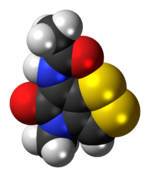Thiolutin
Appearance
 | |
 | |
| Clinical data | |
|---|---|
| Other names | N-(8-methyl-7-oxo-3,4-dithia-8-azabicyclo[3.3.0]octa-1,5-dien-6-yl)acetamide, farcinicin, propiopyvothine, acetopyrrothine |
| ATC code |
|
| Identifiers | |
| |
JSmol) | |
| |
| |
| | |
Thiolutin is a sulfur-containing antibiotic, which is a potent inhibitor of bacterial and yeast RNA polymerases.mRNA stability. Studies have shown that thiolutin inhibits adhesion of human umbilical vein endothelial cells (HUVECs) to vitronectin and thus suppresses tumor cell-induced angiogenesis in vivo.
Thiolutin is formed in submerged fermentation by several strains of Streptomycetes luteosporeus. Some sources erroneously specify "aureothricin" as a synonym of thiolutin. Aureothricin is an antibiotic very similar to thiolutin, and is created as a by-product during the thiolutin fermentation.[2]
References
- S2CID 9211151.
- ^ Fermentek product page
